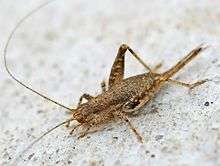Grylloidea
| Grylloidea Temporal range: Triassic - Recent 230–0 Ma | |
|---|---|
 | |
| Arachnocephalus vestitus | |
| Scientific classification | |
| Kingdom: | Animalia |
| Phylum: | Arthropoda |
| Subphylum: | Hexapoda |
| Class: | Insecta |
| Order: | Orthoptera |
| Suborder: | Ensifera |
| Superfamily: | Grylloidea |
| Families | |
|
| |
Grylloidea is a superfamily of insects in the order Orthoptera. It includes the true crickets, the mole crickets, the scaly crickets and the ant crickets, and two families only known from fossils.
Grylloidea dates from the Triassic period and contains about 3,700 known living species in some 528 genera, as well as 43 extinct species and 27 extinct genera.[1]
Characteristics
The features which distinguish crickets in the superfamily Grylloidea from other Ensiferans are long, thread-like antennae, three tarsal segments, slender tactile cerci at the tip of the abdomen and bulbous sensory bristles on the cerci. They are the only insects to share this combination of characteristics. The term cricket is widely, but loosely, used to describe any cricket-like insect in the order Ensifera, being applied to bush crickets (Tettigoniidae), Jerusalem crickets (Stenopelmatus), camel crickets and cave crickets (Rhaphidophoridae) and wetas (Anostostomatidae), and the relatives of these. All these insects have four tarsal segments and are probably more closely related to each other than they are to the true crickets, Gryllidae.[1]
The body is cylindrical in most Grylloideans, but in some it is oval. The antennae are long and threadlike, except in the family Gryllotalpidae in which they are much shorter and brush-like. The pronotum is unkeeled and the sternal plates are flat, unadorned with flaps or spines. The tarsus has three segments and the tibia of the front leg bears the sound-detecting tympanal organs. The forewing of males bears the stridulatory organ, with a sound being created when a file on one wing is rubbed by a scraper on the other. There are two cerci at the tip of the abdomen and there is no stylus on the subgenital plate. In the Gryllotalpidae, the forelimbs are modified for digging and the hind limbs for running.[2]
Classification
The following families form part of this superfamily :[3]
- Baissogryllidae Gorochov, 1985 †
- Gryllidae Laicharting, 1781
- Gryllotalpidae Leach, 1815
- Mogoplistidae Brunner von Wattenwyl, 1873
- Myrmecophilidae Saussure, 1874
- Protogryllidae Zeuner, 1937 †
References
- 1 2 Vincent H. Resh; Ring T. Cardé (2009). Encyclopedia of Insects. Academic Press. p. 232. ISBN 978-0-08-092090-0.
- ↑ Knud Th Holst (1986). The Saltatoria - Bush-Crickets, Crickets and Grass-Hoppers of Northern Europe. BRILL. pp. 50–56. ISBN 90-04-07860-6.
- ↑ "Superfamily Grylloidea - Laicharting, 1781". Orthoptera Species File Online. Retrieved 8 May 2015.